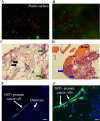Modeling the Human Bone-Tumor Niche: Reducing and Replacing the Need for Animal Data
- PMID: 32258970
- PMCID: PMC7117847
- DOI: 10.1002/jbm4.10356
Modeling the Human Bone-Tumor Niche: Reducing and Replacing the Need for Animal Data
Abstract
Bone is the most common site for cancer metastasis. Understanding the interactions within the complex, heterogeneous bone-tumor microenvironment is essential for the development of new therapeutics. Various animal models of tumor-induced bone disease are routinely used to provide valuable information on the relationship between cancer cells and the skeleton. However, new model systems exist that offer an alternative approach to the use of animals and might more accurately reveal the cellular interactions occurring within the human bone-tumor niche. This review highlights replacement models that mimic the bone microenvironment and where cancer metastases and tumor growth might be assessed alongside bone turnover. Such culture models include the use of calcified regions of animal tissue and scaffolds made from bone mineral hydroxyapatite, synthetic polymers that can be manipulated during manufacture to create structures resembling trabecular bone surfaces, gel composites that can be modified for stiffness and porosity to resemble conditions in the tumor-bone microenvironment. Possibly the most accurate model system involves the use of fresh human bone samples, which can be cultured ex vivo in the presence of human tumor cells and demonstrate similar cancer cell-bone cell interactions as described in vivo. In addition, the use of mathematical modeling and computational biology approaches provide an alternative to preliminary animal testing. The use of such models offers the capacity to mimic significant elements of the human bone-tumor environment, and complement, refine, or replace the use of preclinical models. © 2020 The Authors. JBMR Plus published by Wiley Periodicals, Inc. on behalf of American Society for Bone and Mineral Research.
Keywords: ANIMAL MODELS; BONE MODELING; BONE REMODELING; CANCER; TUMOR‐INDUCED BONE DISEASE.
© 2020 The Authors. JBMR Plus published by Wiley Periodicals, Inc. on behalf of American Society for Bone and Mineral Research.
Figures


Similar articles
-
Ex Vivo Organ Cultures as Models to Study Bone Biology.JBMR Plus. 2020 Feb 14;4(3):10.1002/jbm4.10345. doi: 10.1002/jbm4.10345. eCollection 2020 Mar. JBMR Plus. 2020. PMID: 32161838 Free PMC article. Review.
-
Tumor Cell Dormancy and Reactivation in Bone: Skeletal Biology and Therapeutic Opportunities.JBMR Plus. 2019 Jan 7;3(3):e10125. doi: 10.1002/jbm4.10125. eCollection 2019 Mar. JBMR Plus. 2019. PMID: 30918917 Free PMC article. Review.
-
Bone as a Preferential Site for Metastasis.JBMR Plus. 2019 Jan 15;3(3):e10126. doi: 10.1002/jbm4.10126. eCollection 2019 Mar. JBMR Plus. 2019. PMID: 30918918 Free PMC article. Review.
-
Why Animal Experiments Are Still Indispensable in Bone Research: A Statement by the European Calcified Tissue Society.J Bone Miner Res. 2023 Aug;38(8):1045-1061. doi: 10.1002/jbmr.4868. Epub 2023 Jul 4. J Bone Miner Res. 2023. PMID: 37314012 Free PMC article. Review.
-
In Vitro 3D Cultures to Reproduce the Bone Marrow Niche.JBMR Plus. 2019 Oct 1;3(10):e10228. doi: 10.1002/jbm4.10228. eCollection 2019 Oct. JBMR Plus. 2019. PMID: 31687654 Free PMC article. Review.
Cited by
-
Ex vivo Bone Models and Their Potential in Preclinical Evaluation.Curr Osteoporos Rep. 2021 Feb;19(1):75-87. doi: 10.1007/s11914-020-00649-5. Epub 2021 Jan 11. Curr Osteoporos Rep. 2021. PMID: 33428030 Free PMC article. Review.
-
Droplet Microfluidics for Tumor Drug-Related Studies and Programmable Artificial Cells.Glob Chall. 2021 May 7;5(7):2000123. doi: 10.1002/gch2.202000123. eCollection 2021 Jul. Glob Chall. 2021. PMID: 34267927 Free PMC article. Review.
-
3D-printed β-TCP scaffold as a bone-mimicking environment for an engineered model of osteosarcoma: In vitro properties and transcriptomic insights.Mater Today Bio. 2025 Apr 12;32:101766. doi: 10.1016/j.mtbio.2025.101766. eCollection 2025 Jun. Mater Today Bio. 2025. PMID: 40290888 Free PMC article.
-
Wnt Signaling in the Development of Bone Metastasis.Cells. 2022 Dec 5;11(23):3934. doi: 10.3390/cells11233934. Cells. 2022. PMID: 36497192 Free PMC article. Review.
-
Trends in Bone Metastasis Modeling.Cancers (Basel). 2020 Aug 17;12(8):2315. doi: 10.3390/cancers12082315. Cancers (Basel). 2020. PMID: 32824479 Free PMC article. Review.
References
-
- Lipton A. Clinical features of cancer‐bone disease. 2nd ed Bristol, UK: BioScientifica; 2012.
Publication types
Grants and funding
LinkOut - more resources
Full Text Sources
